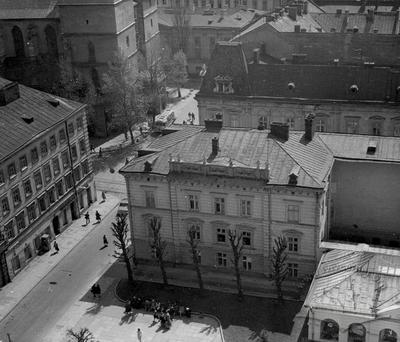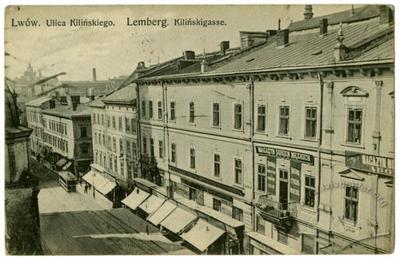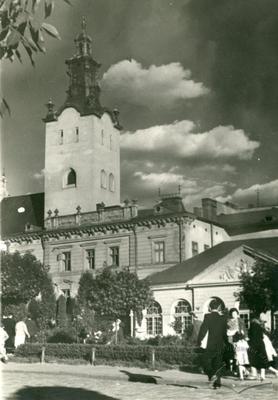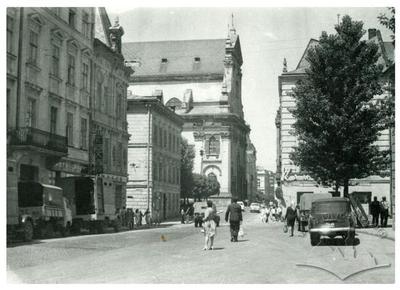Vul. Teatralna, 11 – residential building
The building on Teatralna street 11 preserves the structure of two medieval townhouses in its basis and contains a part of the western wall of the town’s fortifications. It was built by well-known Lviv constructors, Mateo Brezani and Adolf Kamienobrodzki, and decorated by sculptor Leonard Marconi. The building was owned by respected Lviv citizens: Józef Poniński, the Hartmanns and the Zibers. Different institutions were located there, such as the Building Trade Credit Society, the state employment agency, the city address bureau, as well as various educational institutions in the Soviet time and later. The building is an architectural monument of local significance (protection no. 1039).
Architecture
The three-storied corner building is constructed in the Neo-Renaissance style. Its three façades overlook Teatralna and Beryndy streets and the Ivana Pidkovy square. The building is L-shaped in plan; it has cellars and is covered with a full and double-pitched tin roof. The brick and stone building is plastered; it was constructed on stone cellars of two medieval townhouses (those of Abicht and Nose) which had preserved their two-part and three-tract structure and were traditionally divided by a firewall (vaulted cellars and the ground floor have been preserved, as well as the boundary wall with a discharging arch on the cellars level). The western premises of the cellars adjoin the western wall of the town’s fortifications.
The façades are divided horizontally by cornices between tiers (the middle one is decorated with a Vitruvian scroll moulding) and topped with cornice supported by modillions decorated with acanthus leaves and garlands. The frieze is notable for round roof windows; there are also medallions with high relief lion mascarons on the east façade. The façade walls are decorated with banded rustication; the ground floor is emphasized chamfered rustication. The east façade compositional layout (on Teatralna street) combines two old three-window townhouses divided by broader piers; the main entrance shows that this is the principal façade. In the five-axis north façade composition, the three-window middle part is emphasized by pilasters and accentuated by an attic, which is crowned by six vases decorated with lion heads. The south façade is cut by ten axes of windows, with an entrance. The window openings are decorated with trimmings having triangular (on the 2nd floor) and linear (on the 3rd floor) pediments. There are lucarnes in the roofs.
As regards the planning structure, the main house has three tracts; a part of the house belongs to the corridor type (originally with a gate passage). A narrow entryway, covered with a cross vault, leads to the wooden staircase and farther, to the courtyard. The cellars can be reached by three entrances: the first one leads via metal stairs from the southeastern corner room to the cellar below; the second one leads via metal winding stairs from the premises facing Beryndy street to the cellar situated under these premises; the other cellars can be entered via stone stairs located under the wooden staircase. All floors have flat bridgings supported by wooden beams; the soffit is covered with reed and plastered.
The building is a bright monument of the Lviv 19th century architecture; the structure of two medieval townhouses has survived in its basis, as well as a part of the western wall of the town fortifications which has been integrated in its structure.
Personalities
Albert
Kornbluth – an architect.
Alfred
Kamienobrodzki – an architect who designed a project of the
townhouse reconstruction in 1880.
Antoni
Ziber – an owner of the house from 1870 who reconstructed the house at his
own cost.
Dr Barącz – a
lawyer who owned the house from 1912.
Beno
Klaften – a footwear trader.
Władysław Opolczyk – a governor of Galicia in the 14th
c.
Volodymyr
Pidhorodetsky (Włodzimierz
Podhorodecki) – a Lviv architect.
Genowefa
Ziber – an owner of the house from 1870.
Hersch
Bornfeld – a men’s clothes trader.
Irena
Rustel – a daughter of Klementina Hartmann who inherited the townhouses on the
Św. Ducha square in 1856.
Karl
Hartmann – a Lviv citizen who built townhouses (conscription nos. 32 and 360)
and the town guardhouse on the Św. Ducha
square at his own cost in 1827.
Klementina
Rustel (Hartmann), baroness – Karl Hartmann’s daughter who
inherited the townhouses on the Św. Ducha square
in 1848.
Leonard
Marconi – a well-known sculptor who designed the townhouse’s Neo-Renaissance façades.
Mateo
Brezani – an architect who constructed the townhouses and the guardhouse on the Św. Ducha square.
Piotrowicz – a
co-owner of the Piotrowicz & Szumann trading
company from Lviv.
Stanisław Uleniecki – a
constructor.
F.
Iwanejko – an owner of a confectionery located in the house premises.
F. Nose – an
owner of the Kravetska townhouse in the early 18th c.
Filipowski
– a nobleman who had a townhouse built for the hospital priest.
Franciszka
Sawczyńska
(Ziber) – a co-owner of the houses.
Szumann – a
co-owner of the Piotrowicz & Szumann trading
company from Lviv.
Józef Poniński – a voivode of Poznan who merged two old townhouses into a single one
in 1763.
Józef Thorn – an
architect.
Jan
Abicht – an owner of the townhouse of Tomasz the baker from the early 18th
c.
Jan
Tomasz Kudelski – an architect.
Jan Jakob – an
owner of a part of the residential house no. 32 from 1868.
Sources
- Austrian National Library, FKB 274-68, Manuscript Map of Lviv (1828)
- Kriegsarchiv, GIh 371, Map of Lviv by Joseph Daniel von Huber (1777)
- Kriegsarchiv, GIh 372-8, Manuscript Map of Lviv (1802)
- Archive of the Department of Restoration and Reconstruction of Architectural Complexes at Lviv Polytechnic National University. M. Freydun Master Thesis Project of Restoration and Adaptation of the House on Teatralna Street 11 for a Lviv Polytechnic Conference Center Building (scientific advisors Mykola Bevz and Yuriy Dubyk). 2012
- State Archive of Lviv Oblast (DALO) 2/2/5239.
- Central State Historical Archive of Ukraine in Lviv (CDIAL) 186/8/631.
- Czerner O., Lwów na dawniej rycynie i planie (Wrocław-Warszawa-Kraków, 1997).
- Jaworski F., O szarym Lwowie (Lwów-Warszawa: Biblioteka historyczna Altenberga, 1914).
- Архітектура Львова. Час і стилі (Львів: Центр Європи, 2008).
- Зубрицький Д., Хроніка міста Львова (Львів: Центр Європи, 2002), 62.
- Котлобулатова Ірина, Львів на фотографії-1 (Львів: Видавництво "Центр Європи", 2006).
- Котлобулатова Ірина, Львів на фотографії-2 (Львів: Видавництво "Центр Європи", 2011).
- Львів. Ілюстрований путівник (Львів, 2000).
- Мельник Б., Вулицями старовинного Львова (Львів: Світ, 2002).
- Мельник Б., Довідник перейменувань вулиць і площ Львова (Львів: Світ, 2001).
- Могитич Р., "Ліктьовий податок 1767 року у Львові", Вісник Інституту Укрзахідпроектреставрація, 2009, Ч. 19.
- Сьомочкін Ігор, "Наріжний будинок на вул. Памви Беринди, 1 / Театральна, 9", Вісник Інституту Укрзахідпроектреставрація, 2008, Ч. 18, 177-184.
Media Archive Materials
Related Pictures















